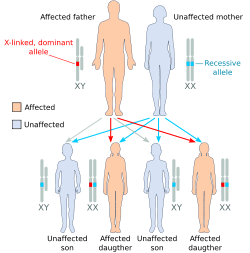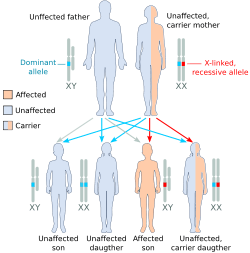Sex linkage

Sex linkage is the phenotypic expression of an allele related to the allosome (sex chromosome) of the individual. In autosomal chromosomes both sexes have the same probability of existing (see Fisher's principle), but since humans have many more genes on the female X chromosome than on the male Y chromosome, these are much more common than Y-linked traits.
In mammals, the female is homogametic, with two X chromosomes (XX), while the male is the heterogametic sex, with one X and one Y chromosome (XY). Genes on the X or Y chromosome are called sex-linked. In ZW sex-determination system used by birds the opposite is true: the male is the homogametic sex (ZZ), and the female is heterogametic (ZW).
X-linked recessive traits are expressed in all heterogametics, but are only expressed in those homogametics that are homozygous for the recessive allele. For example, an X-linked recessive allele in humans causes haemophilia, which is much more common in males than females because they are hemizygous (see zygosity) and therefore express the trait when they inherit one mutant allele. In contrast, a female must inherit two mutant alleles, a less frequent event since the mutant allele is rare in the population.
The incidence of recessive X-linked phenotypes in females is the square of that in males (squaring a proportion less than one gives an outcome closer to 0 than the original). If 1 in 20 males in a human population are red-green color blind, then 1 in 400 females in the population are expected to be color-blind (1/20)*(1/20). (The term 'color-blind' is not completely accurate. There are degrees of weakness in color vision and it is now called 'color vision deficiency'.)
X-linked traits are maternally inherited from carrier mothers or from an affected father. Each son born to a carrier mother has a 50% probability of inheriting the X-chromosome carrying the mutant allele. There are a few Y-linked traits; these are inherited from father.
In classical genetics, a reciprocal cross is performed to test if a trait is sex-linked.
(A)  |
(B)  |
(C)  |
| Illustration of some X-linked heredity outcomes (A) the affected father has one X-linked dominant allele, the mother is homozygous for the recessive allele: only daughters (all) will be affected. (B) the affected mother is heterozygous with one copy of the X-linked dominant allele: both daughters and sons will have 50% probability to be affected. (C) the heterozygous mother is called "carrier" because she has one copy of the recessive allele: sons will have 50% probability to be affected, 50% of unaffected daughters will become carriers like their mother.[2] |
X-linked dominant inheritance

Each child of a mother affected with an X-linked dominant trait has a 50% chance of inheriting the mutation and thus being affected with the disorder. If only the father is affected, 100% of the daughters will be affected, since they inherit their father's X-chromosome, and 0% of the sons will be affected, since they inherit their father's Y-chromosome.
Examples
- Alport's syndrome
- Aarskog-Scott syndrome
- Coffin–Lowry syndrome (CLS)
- idiopathic hypoparathyroidism
- incontinentia pigmenti
- Ornithine carbamoyltransferase deficiency
- Rett syndrome (RS)
- vitamin D resistant rickets
- fragile X syndrome
X-linked recessive inheritance
Females possessing one X-linked recessive mutation are considered carriers and will generally not manifest clinical symptoms of the disorder. All males possessing an X-linked recessive mutation will be affected, since males have only a single X-chromosome and therefore have only one copy of X-linked genes. All offspring of a carrier female have a 25% chance of inheriting the mutation if the father does not carry the recessive allele. All female children of an affected father will be carriers (assuming the mother is not affected or a carrier), as daughters possess their father's X-chromosome. If the mother is not a carrier, no male children of an affected father will be affected, as males only inherit their father's Y-chromosome.
Examples
- ALD
- Duchenne muscular dystrophy
- Hunter syndrome
- Menkes disease (kinky hair syndrome)
- Glucose-6-phosphate dehydrogenase deficiency
- Haemophilia A and B
- Fabry's disease
- Wiskott-Aldrich syndrome
- Bruton's agammaglobulinemia
- Color blindness
- Complete androgen insensitivity syndrome
- Congenital aqueductal stenosis (hydrocephalus)
- Inherited nephrogenic diabetes insipidus
Y-linked
- VAJ
Various failures in the SRY genes
Sex-linked traits in other animals
- White eyes in Drosophila melanogaster flies— the first sex-linked gene discovered.[3]
- Fur color in domestic cats: the gene that causes orange pigment is on the X chromosome; thus a Calico or tortoiseshell cat, with both black (or gray) and orange pigment, is nearly always female.
- The first sex-linked gene ever discovered was the "lacticolor" X-linked recessive gene in the moth Abraxas grossulariata by Leonard Doncaster.[4]
Related terms
It is important to distinguish between sex-linked characters, which are controlled by genes on sex chromosomes, and two other categories.[5]
Sex-influenced traits
Sex-influenced or sex-conditioned traits are phenotypes affected by whether they appear in a male or female body.[6] Even in a homozygous dominant or recessive female the condition may not be expressed fully. Example: baldness in humans.
Sex-limited traits
These are characters only expressed in one sex. They may be caused by genes on either autosomal or sex chromosomes.[6] Examples: female sterility in Drosophila; and many polymorphic characters in insects, especially in relation to mimicry. Closely linked genes on autosomes called "supergenes" are often responsible for the latter.[7][8][9]
See also
References
- ↑ Morgan, Thomas Troy 1919. The physical basis of heredity. Philadelphia: J.B. Lippincott Company.
- ↑ Genetics home reference (2006), genetic conditions illustrations, National Library of Medicine.
- ↑ Morgan T.H. 1910. Sex-limited inheritance in Drosophila. Science 32: 120-122
- ↑ Doncaster L. & Raynor G.H. 1906. Breeding experiments with Lepidoptera. Proceedings of the Zoological Society of London. 1: 125-133
- ↑ Zirkle, Conrad 1946. The discovery of sex-influenced, sex limited and sex-linked heredity. In Ashley Montagu M.F. (ed) Studies in the history of science and learning offered in homage to George Sarton on the occasion of his sixtieth birthday. New York: Schuman, p167–194.
- 1 2 King R.C; Stansfield W.D. & Mulligan P.K. 2006. A dictionary of genetics. 7th ed, Oxford University Press. ISBN 0-19-530761-5
- ↑ Mallet J.; Joron M. (1999). "The evolution of diversity in warning color and mimicry: polymorphisms, shifting balance, and speciation". Annual Review of Ecology and Systematics. 30: 201–33. doi:10.1146/annurev.ecolsys.30.1.201.
- ↑ Ford E.B. 1965. Genetic polymorphism. p17-25. MIT Press 1965.
- ↑ Joron M, Papa R, Beltrán M, et al. (2006). "A conserved supergene locus controls colour pattern diversity in Heliconius butterflies". PLoS Biol. 4 (10): e303. doi:10.1371/journal.pbio.0040303. PMC 1570757
 . PMID 17002517.
. PMID 17002517.